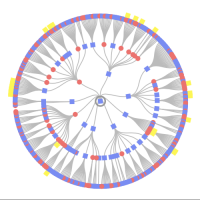possibly a new research method for family tree
Hi
I hope this email finds you and those close to you in good health and peace of mind.
I have a new role as a family history consultant in my local chapel and I have, what I think is, a new idea for family history research in the family tree.
You may have heard of One Name Studies. This is where people interested in a certain surname get together to research it and build families. This organisation: Guild of One-Name Studies – One-name studies, Genealogy offers a service to gather people to work on a particular surname, but to have a one name study with them, one has to pay them. The cost of a new membership and to register a study, is GBP 32, with an annual membership fee of GBP 18. I have once found a One Name Study with them, for a surname in my family tree: Appleby.
In my family history research, I found that I needed to build families to see if any members matched the info I had on a person. This is quite easy during the time of the UK household and individual Census, 1841 +, but before then, I decided to focus on marriage records. Sometimes for a change, I would do a broader study of all marriages with a particular surname in a certain area. The biggest I have done is a Neilson surname study in Scotland. You can see it here: https://www.familysearch.org/tree/pedigree/landscape/GFPW-K83.
The idea is to search for marriages from the earliest time period and group them by shire/county, as the grooms with the particular name, in this case Neilson, could be relatives. When one exhausts the records for an earlier period, e.g. 1600-1700, then one moves to the next period, e.g. 1700 to 1800. If there is a specific earliest couple for a shire, then they become the surrogate/temporary parents as in the above: Thomas Neilson and Christina McNab.
It so happens that the original person who entered this couple, Lynne Kunz (see Christina McNab's profile), did not supply any sources, which is not recommended, as our tree should be source based. I would not have put specific names without sources.
Then couples married with sources, which give a place, are added to a father or parents, who have sources and are of the appropriate age. If no parent with sources is found, then a theoretical father is created, with the shire as his given name. Thus we have, for Thomas Neilson: three sons from different shires and in this case, no daughters. We also have three theoretical sons with the given names of: Aberdeen, Haddington and Dunfermline. Under each of those supposed, or theoretical 'children' of Thomas, are grouped all the marriages from either the shire in which the child and the spouse married, or the shire of the theoretical child's first name.
Generations of marriages are added according to these principles. Mostly I was starting with just a marriage record and there were no children, so the couple was given a theoretical birth year of the marriage year -21.
Husbands with the same surname (town) and shire/county as the couple and born within 45y of the mother, would be grouped with parents of the right age and location. Thus, sons and daughters born within 24 years, in the same (town and) shire, are grouped as possible siblings.
The next stage could be to search for children for each couple or for christening records for the husband and the suggested parent.
As times goes on and more information is found about supposed siblings, they are left in the family, or another family is created for them.
I put a note with the parents that the children have been 'adopted' into this family, until the relationship is confirmed, or their true parents are found.
I understand we should not use the family tree as a sandbox, but there seems to be a gap in the service, which other family history sites offer, which could help greatly in uniting families.
I offer this as a possible way of finding and building families. If you have any questions, please feel free to ask me.
best wishes
Joe
Comments
-
Sounds like an intriguing way of using statistical analysis in genealogy.
But please only do this off-line in a private database that will never get on the internet. Please do not create fictitious information in Family Tree, particularly not fictitious family relationships, even temporarily. Inaccurate information is so hard to stamp out once it is on-line. Family Tree has enough trouble with this without purposely adding more.
The process you describe also makes a big mess of the Change Log with all the incorrect merges making it extremely difficult to find the initial, correct although sparse, information on a person.
(Looking at your example, an additional concern as a member of the church is that it appears that various people are proceeding with ordinance work for people with no first names, no sources, and your admittedly fictitious "adoptions.")
1 -
Please do not use profiles of actual persons as placeholders. Using placeholders at all is frowned on by many contributors. I use placeholders but I make it very clear that they are just that, and I make them not usable for LDS ordinances. I use them only when I have tried and failed to find the parents.
Other tools available to you include your Following list on Family Tree, which can hold up to 4000 profiles. Also, if you buy a Puzzilla premium subscription ($40/yr) you get a research log that works similar to the Following list. Finally, there are many 3-rd party desktop computer programs for working with Family Tree.
1
